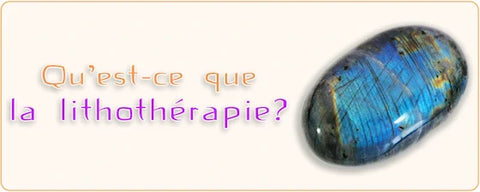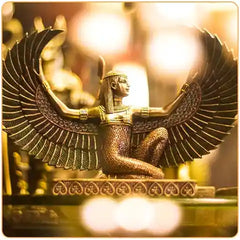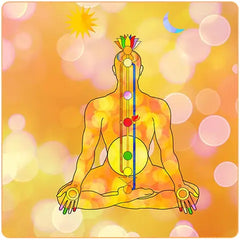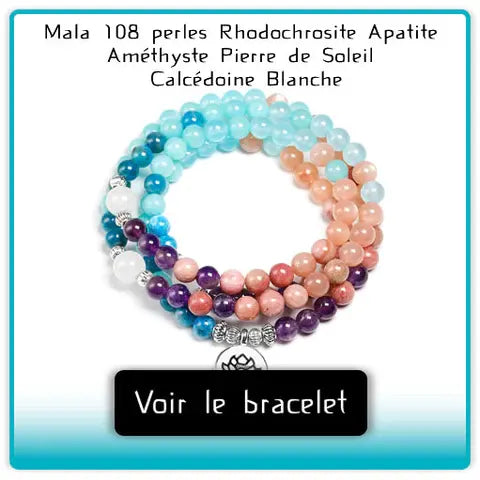What is lithotherapy?

The word "lithotherapy" comes from the Greek words "lithos," meaning "stone," and "therapeia," meaning "treatment." Lithotherapy is therefore literally " therapy with stones ." It is a practice that uses the energetic properties of stones and crystals to improve physical, emotional, and spiritual health. In lithotherapy, it is often believed that stones emit particular energetic vibrations that can influence our body and mind. Different stones are thought to have unique vibrations associated with specific properties, such as healing, protection, inner peace, and so on. However, it is important to note that this idea is not supported by solid scientific evidence. Most of the effects of lithotherapy are considered psychological, based on the placebo effect and the belief in their therapeutic properties . Nevertheless, many people use stones and crystals for their beauty, spiritual development, and to improve their well-being. It is a very popular practice today.
Kaosix offers a wide selection of gemstone and crystal jewelry , such as bracelets, necklaces, and pendants. We believe in the power of gemstones and crystals to enhance people's lives.
In this article, we will explore crystal healing in depth and answer some of the most common questions on the subject, such as the origins of crystal healing and how it became popular in the modern world. How is crystal healing explained? Does crystal healing really work? We will also discuss the stones used in crystal healing, their meanings, their effects on our well-being, and how to choose them. Finally, we will examine the relationship between crystal healing, the seven chakras, and the colors of the stones.
Who created lithotherapy?
Lithotherapy has existed for thousands of years and has been used by many cultures around the world, such as Egypt, Greece, India, and China , where stones and crystals were considered to possess purported therapeutic properties and were used to treat various physical and emotional ailments. Stones were also often associated with deities and spiritual beliefs.
The exact origin of crystal healing is unclear, but it is believed to date back to prehistoric times, when early humans began using stones for protection and healing. Some of the earliest civilizations to use crystal healing were the Egyptians, Babylonians, Greeks, and Romans.
Over time, crystal healing has evolved and been influenced by different cultures and beliefs. For example, it has been used by shamans to treat spiritual illnesses and has been incorporated into the traditional medical practices of some cultures.
Today, crystal healing is increasingly popular as a way to heal and relax naturally. It can be used alone or in conjunction with other treatments. Stones can be worn as jewelry or used during meditation or energy healing sessions. Crystal healing is an ancient practice that has transcended centuries and cultures to become a popular method of self-care . It can be used by anyone seeking to improve their well-being and explore the benefits that stones and crystals can offer.

How is lithotherapy explained?
In geology, minerals are classified into seven main categories: silicates, sulfates, sulfides, carbonates, halogens, oxides, and phosphates. Each of these categories includes many different minerals, each with unique properties. In crystal healing, the different classes of minerals can be used for their particular properties, which some believe can help improve our well-being. For example, silicate stones, such as amethyst and quartz, can help calm emotions and promote meditation . Carbonate stones, such as calcite and aragonite, can help calm nerves and relieve stress. Phosphate stones, such as tourmaline and variscite, can help boost creativity and productivity .
There are several theories about how crystal healing works. Some people believe that stones and crystals can transfer their energy and vibrations to our bodies, thus helping to balance our energy centers (see the section on the 7 chakras further down in the article). Others consider crystal healing a form of placebo (Journal Des Femmes Santé) , meaning that the therapeutic effect stems from the belief in its properties.
There are few rigorous scientific studies on the effectiveness of crystal healing, and those that exist have not provided conclusive evidence of its efficacy. Crystal healing is often considered an alternative or complementary approach to medicine . However, many people experience subjective benefits for their emotional and spiritual well-being, which they may consider evidence of its effectiveness. Ultimately, the decision to try crystal healing depends on the individual and their personal beliefs.
Despite these differences of opinion, many people report tangible benefits from crystal healing . It can help reduce stress, improve sleep quality, increase concentration, strengthen the immune system, and promote overall well-being. It's important to remember that crystal healing should not be used to replace medical treatment, but rather as a complement, based on individual experiences and beliefs.
Does crystal healing really work?
There is no definitive answer to this question, as crystal healing is a subjective practice and the concept of its effectiveness depends on each individual's personal beliefs. Since time immemorial, crystal healing has been used to improve mental and physical health (Doctissimo Alternative Medicine) , but some people remain skeptical about its efficacy. However, crystal healing is based on simple principles that can explain its effectiveness. Crystal healing is based on the idea that stones and crystals are sources of natural energy and that by wearing them or keeping them close, we can receive this energy and benefit from their positive effects on our bodies. The properties of stones and crystals can also help balance the chakras, calm the mind, and relieve stress (see the section on the 7 chakras further down in the article).
Some people may experience real benefits from using stones and crystals in crystal healing, while others may not notice any particular effects. It's important to remember that crystal healing is considered an alternative practice. Although scientific evidence for the effectiveness of crystal healing is limited, there are studies that have shown that stones and crystals can indeed have an impact on mental and physical health (Ça m'intéresse Santé) . For example, one study showed that wearing gemstones can reduce stress and improve mood .
Ultimately, crystal healing works for some and may not work for others. However, since it has no negative side effects, there's no harm in trying it and seeing if it works for you.

What are the stones used in lithotherapy, their effects on our well-being, and how do we choose them?
There are many different stones used in crystal healing, each with its own unique properties. Depending on their color, mineral composition, and symbolic meaning , stones can influence our energy, mood, concentration, self-confidence, and emotional balance. Some stones can also help treat physical pain, insomnia and sleep disorders, digestive problems, stress, and anxiety, among other things. Stones can be used alone or in combination with other methods, such as meditation, to improve overall well-being .
1) The most commonly used stones
Here is a non-exhaustive list of the most commonly used stones in lithotherapy and their corresponding properties:
- Amethyst is often associated with healing, meditation, spirituality, serenity, and protection against negative influences.
- Aquamarine is known for its calming and soothing properties for the mind and body, as well as for its support in situations of stress and emotional challenges.
- Citrine is considered a stone of good luck and abundance; it is frequently used to boost creativity, motivation, and self-confidence.
- Rose quartz is generally associated with love, compassion, and emotional healing; it is used to soothe feelings of sadness, loneliness, and grief.
- Rock crystal is considered a powerful stone for healing and harmonizing energy; it is used to improve mental clarity and concentration.
- Tiger's eye is often associated with protection, confidence and determination; it is used to stimulate vitality, courage and inner strength.
- Red jasper is usually associated with stability, strength and grounding; it is used to help develop self-confidence and overcome fears.
- Malachite is often associated with transformation, healing and protection; it is used to help purify negative energy and balance emotions.
- Lapis lazuli is generally associated with spirituality, wisdom and self-expression; it is used to enhance communication, understanding and creativity.
- Turquoise is frequently associated with healing, protection and strength; it is used to improve emotional balance and serenity.
- Obsidian is often associated with protection, purification and healing; it is used to help overcome fears and emotional blockages.
- Rhodonite is primarily associated with emotional healing, unconditional love and compassion; it is used to help overcome trauma and feelings of rejection.
- Selenite is usually associated with healing, mental clarity and protection; it is used to help clear energy blockages and mental tension.
- Sodalite is generally associated with communication, understanding, and rationality; it is used to help develop self-confidence and overcome fears.
2) The choice of stones
There are several approaches to choosing the stones that resonate with us. One is based on the properties and meanings of each stone , such as healing, energy, love, protection, and so on. It's important to consider your personal needs and choose a stone that corresponds to those needs. You can also choose a stone based on its color , which can be associated with a particular chakra (see the section on chakras and colors further down in the article). It's also possible to choose a stone by touching or wearing it and observing how you feel. Finally, some practitioners of crystal healing suggest choosing a stone by trusting your intuition or a spontaneous attraction to a particular stone. Choosing a stone using your intuition means trusting your inner feelings and instincts to select the stone that resonates best with you. There are several ways to do this:
- Observe the stones: simply look at the stones and focus on the one that catches your eye. If you feel a particular attraction to a stone, it's often a sign that this stone resonates with your energy.
- Hold the stones in your hand: it is possible to hold the stones in your hand and feel their energy. If a stone gives you a feeling of calm, peace, or comfort, this may indicate that it is the right stone for you.
- Listen to your body: if you feel a physical reaction when touching a stone, it may be a sign that it's the right stone for you. For example, if you feel warmth or tingling when you touch a stone, this may indicate that it's the right stone for you.
- Note that choosing a stone using your intuition can vary depending on your personal needs and goals. It is therefore important to connect with yourself and trust your intuition when choosing a stone for crystal healing .
It is important to understand the meaning of each stone before using them in crystal healing. You can find charts of stone meanings (Pinterest) online or in books on crystal healing.
3) Purification and recharging of the stones
When choosing a stone for crystal healing, it's important to cleanse and recharge it regularly to maintain its strength and energy . Here are some of the most common methods for cleansing or recharging:
- Purification by water: immerse the stone in salt water or distilled water to purify it.
- Purification by earth: bury the stone in the ground for several hours to purify it.
- Purification by smoke: use incense or sage smoke to purify the stone by passing it through the smoke.
- Solar charging: expose the stone to sunlight to recharge it.
- Lunar recharge: expose the stone to moonlight to recharge it.
- Recharging with salt: You can place the stones in a bowl of salt and leave them to soak for several hours. The salt can cleanse and regenerate the vibrations of the stones.
- Recharging with other stones: you can place the stones to be recharged near other stones such as crystal quartz, black tourmaline or selenite which have cleansing and recharging properties.
It is important to note that each stone has its own specific cleansing and recharging needs, so it is best to consult a lithotherapy expert for more detailed instructions.
4) Combinations of several stones
It is also possible to combine several different stones in crystal healing. Many crystal healers use multiple stones to work on different aspects of life or to enhance the effectiveness of the chosen stone. For example, it is common to wear a protective stone with a stone to boost self-confidence, or to use a healing stone with a stone to calm the mind. However, it is important to remember that intuition and personal feelings play a significant role in choosing stones. Therefore, it is advisable to experiment to find the combination that works best for you.

Lithotherapy, the 7 chakras, and colors
Crystal healing is often linked to the seven chakras, which are considered energy centers in the human body according to traditional Indian medicine. The stones are believed to act on the chakras by emitting an energetic frequency that can help balance and strengthen the energies of the respective chakras.
1) Here is a non-exhaustive list of stones associated with the 7 chakras:
- Root Chakra (Muladhara): red jasper, hematite, ruby
- Sacral Chakra (Svadhisthana): carnelian, sunstone, orange calcite
- Solar Plexus Chakra (Manipura): tiger's eye, amber, citrine
- Heart Chakra (Anahata): aventurine, jade, amazonite
- Throat Chakra (Vishuddha): lapis lazuli, turquoise, aquamarine
- Third Eye Chakra (Ajna): labradorite, black obsidian, sodalite
- Crown Chakra (Sahasrara): amethyst, rock crystal, milky quartz
To give you an example, the stone associated with the heart chakra, aventurine, can help relieve stress and improve self-understanding, which in turn can strengthen the energy of the heart chakra.
The colors of gemstones also play a role in crystal healing. Each chakra is associated with a color and a range of different energies, thoughts, and emotions. By using stones of colors corresponding to a particular chakra, one can help balance and strengthen the energies of that chakra.
2) The 7 chakras and their corresponding colors:
- the root chakra (red color)
- the sacral chakra (orange color)
- the solar plexus chakra (yellow color)
- the heart chakra (green color)
- the throat chakra (blue color)
- the third eye chakra (indigo color)
- the crown chakra (purple or white)
For example, red stones such as jasper (root chakra) are considered to be associated with vitality and self-confidence. Green stones such as turquoise (heart chakra) are associated with balance and healing, while purple stones such as amethyst (crown chakra) are used to enhance spiritual understanding. The colors of the stones, by acting on the chakras, contribute to improving overall health by stimulating positive energies.
It is important to note that the colors of stones are only one of the many aspects of their use in crystal healing, and that their effects also depend on their mineral composition, shape, size, and intended use. It is always advisable to conduct thorough research and consult a crystal healing professional if you wish to use stones for therapeutic or energetic purposes.
See our collection of Gemstone Jewelry
In conclusion
Lithotherapy is an ancient practice that uses stones and crystals to improve our physical, emotional, and spiritual well-being. While some remain skeptical about its effectiveness, many people report significant improvements in their lives through the use of stones. Lithotherapy originated in several cultures and civilizations, which have used stones for their healing and protective properties.
In this article, we explored the various aspects of crystal healing, from its origins and how it works to the most commonly used stones, their colors, and their effects on the seven chakras. We also provided advice on choosing the stone that's right for you.
If you are interested in crystal healing, it's important to keep in mind that, like any other natural remedy, results can vary from person to person. However, there's no harm in trying it and discovering the potential benefits of crystal healing for yourself.
We invite readers to explore our collection of gemstone and crystal jewelry to experience the benefits of crystal healing for themselves. Each of our bracelets and pendants is carefully selected for its unique energy and healing power. We are confident you will find the perfect stone to meet your needs.
Disclaimer: The metaphysical and healing properties described above are provided for inspiration and reference purposes only; they are not scientifically proven and should be considered within the context of holistic healing and spiritual practices. We gather this information and these purported properties from writings, books, folk tales, and various other sources. They also depend on the individual's attitude and beliefs. Furthermore, they are not a substitute for diagnosis or treatment by a qualified therapist or physician.

About the author: Elara Vey
Passionate about ancestral traditions and well-being practices, Elara shares her discoveries for Kaosix to help you integrate more harmony and meaning into your daily life.
Discover her journey →

